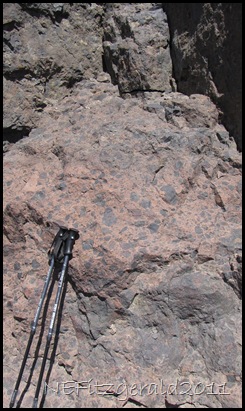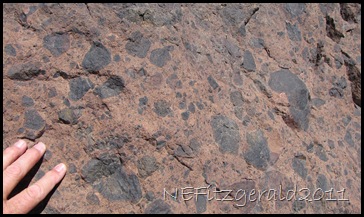If there were one thing I could say about all the volcanic commotion that produced the wondrousness of Yellowstone National Park, it would be that it ain’t over til it’s over. For at least the past fifty million years there has been intermittent explosive volcanism of one sort or another in this region of the western US, and I expect that there will be more to come. Not in our lifetimes, perhaps, but then again you never know…
 |
| Trail to lookout tower on Mt. Washburn |
 |
| On the Mt. Washburn trail |
When some Utah friends visited earlier this month and wanted to hike the six–mile round-trip Dunraven Pass trail to Mt. Washburn lookout tower, I was more than happy to accompany them – this hike was definitely on my summer to–do list. At 10,243 feet above sea level it is one of the highest peaks in the park, offering jaw-dropping 360° views across the expansive Yellowstone caldera eastward towards the Grand Canyon of the Yellowstone and the Absaroka Range, south through the haze to the Grand Tetons, and, outside the rim of the caldera, north to the Beartooth Mountains and northwest to the Gallatin Range. We would find ourselves on a lofty and very windy segment of the northern rim of the caldera.
 |
| View from Mt. Washburn summit |
 |
| Lunch with a view |
 |
| Washburn Range |
All the guidebooks say that if you hike only one short trail in Yellowstone, make sure it is this one. What most of these guidebooks neglect to tell you, however, is that a goodly portion of the mountain was blown to infinity during either or both of the more recent Yellowstone supervolcano explosions – one at 2.1 million years ago and another at 640,000 years ago.
 |
| Washburn Range |
 |
| Crosscutting layers on Mt. Washburn |
Of the two main episodes of volcanism in the Yellowstone area, the Washburn Range Volcano in the north–central part of the park came into existence during an older period of volcanic activity that occurred in northwestern Wyoming 55–40 million years ago during the Eocene epoch. During this tectonically active time other volcanic fields were also formed – the Absaroka Range along the eastern side of the park, Bunsen Peak south of Mammoth Hot Springs in the northern part of the park, and intrusive igneous rocks of the southern Gallatin Range in the northwestern corner of the park.
Picture in your mind, if you will, the eruption in May 1980 of Mt. St. Helens with its lahars or mudslides flowing violently down the mountain slopes, and you will have a pretty good idea of what must have happened during eruptions of Mt. Washburn all those scores of millions of years ago. These lahars and later debris flows surged over the future Yellowstone and quickly enveloped any ancient forest that happened to be their path. In the nearby Specimen Ridge area, fossilized remains of sycamore, walnut, magnolia, chestnut, oak, redwood, maple and dogwood trees testify to a more temperate forest that was buried beneath this volcanic debris from Mt. Washburn. The angular conglomerate or breccia that is everywhere along the trail is evidence of the mudflows that poured off the mountain.
 |
| Angular conglomerate or breccia |
 |
| Angular conglomerate or breccia |
 |
| Angular conglomerate or breccia |
 |
| Angular conglomerate or breccia |
Absaroka volcanism occurred intermittently over several million years and ended around 40 million years ago, leaving a gently undulating volcanic plateau barely a few thousand feet above sea level and strewn with volcanic cones, of which Mt. Washburn was one.
Naturally, much geology happened in the intervening millennia but for now we must jump ahead to the Yellowstone of around 2.1 million years ago. BOOM!!! The first supervolcano explosion occurred at an unimaginably gigantic magnitude, blowing into oblivion nearly 600 cubic miles of subterranean magma chamber and overlying Rocky Mountains along with some fraction of adjacent Mt. Washburn. One and a half million years later BOOM!!! Another smaller yet still supervolcano explosion occurred in the same general area, blowing into oblivion yet another 240 cubic miles of magma chamber and any surrounding Rocky Mountains that happened to be left over from the earlier explosion. Because it is near the rim of the caldera it is most likely that at this time some fresh portion of Mt. Washburn again took a major hit. However, all the breccia I examined on the hike would be from the volcanism of 55–40 million years ago and not from the more recent supervolcano eruptions of the past 2.1 million years.
 |
| Layered volcaniclastic rocks |
 |
| Bighorn sheep on the summit of Mt. Washburn |




















